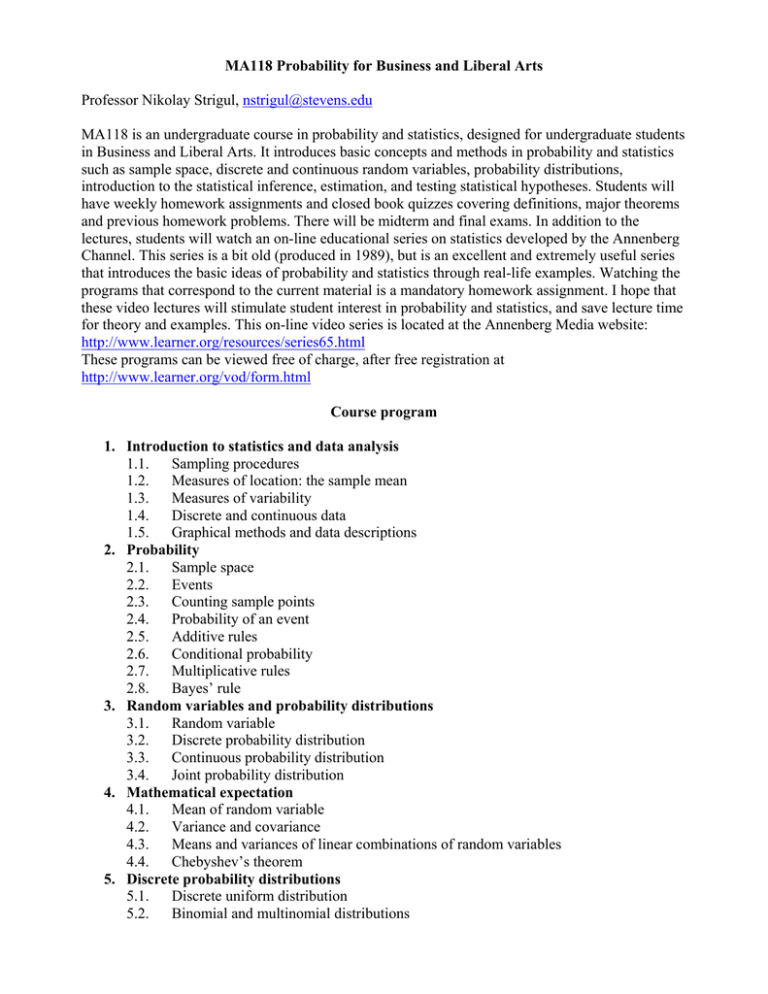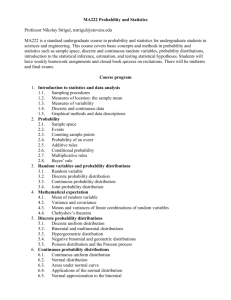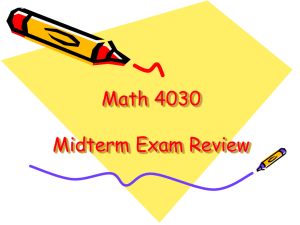MA118 Probability for Business and Liberal Arts Professor Nikolay Strigul,
advertisement

MA118 Probability for Business and Liberal Arts Professor Nikolay Strigul, nstrigul@stevens.edu MA118 is an undergraduate course in probability and statistics, designed for undergraduate students in Business and Liberal Arts. It introduces basic concepts and methods in probability and statistics such as sample space, discrete and continuous random variables, probability distributions, introduction to the statistical inference, estimation, and testing statistical hypotheses. Students will have weekly homework assignments and closed book quizzes covering definitions, major theorems and previous homework problems. There will be midterm and final exams. In addition to the lectures, students will watch an on-line educational series on statistics developed by the Annenberg Channel. This series is a bit old (produced in 1989), but is an excellent and extremely useful series that introduces the basic ideas of probability and statistics through real-life examples. Watching the programs that correspond to the current material is a mandatory homework assignment. I hope that these video lectures will stimulate student interest in probability and statistics, and save lecture time for theory and examples. This on-line video series is located at the Annenberg Media website: http://www.learner.org/resources/series65.html These programs can be viewed free of charge, after free registration at http://www.learner.org/vod/form.html Course program 1. Introduction to statistics and data analysis 1.1. Sampling procedures 1.2. Measures of location: the sample mean 1.3. Measures of variability 1.4. Discrete and continuous data 1.5. Graphical methods and data descriptions 2. Probability 2.1. Sample space 2.2. Events 2.3. Counting sample points 2.4. Probability of an event 2.5. Additive rules 2.6. Conditional probability 2.7. Multiplicative rules 2.8. Bayes’ rule 3. Random variables and probability distributions 3.1. Random variable 3.2. Discrete probability distribution 3.3. Continuous probability distribution 3.4. Joint probability distribution 4. Mathematical expectation 4.1. Mean of random variable 4.2. Variance and covariance 4.3. Means and variances of linear combinations of random variables 4.4. Chebyshev’s theorem 5. Discrete probability distributions 5.1. Discrete uniform distribution 5.2. Binomial and multinomial distributions 5.3. Hypergeometric distribution 5.4. Negative binomial and geometric distributions 5.5. Poisson distribution and the Poisson process 6. Continuous probability distributions 6.1. Continuous uniform distribution 6.2. Normal distribution 6.3. Areas under normal curve 6.4. Applications of the normal distribution 6.5. Normal approximation to the binomial 6.6. Gamma and exponential distributions 6.7. Applications of the gamma and exponential distributions 6.8. Chi-squared distribution 6.9. Lognormal distribution 6.10. Weibull distribution 7. Functions of random variables 7.1. Transformations of variables 7.2. Moments and moment-generation functions 8. Fundamental sampling distributions and data distributions 8.1. Random sampling 8.2. Some important statistics 8.3. Data displays and graphical methods 8.4. Sampling distributions 8.5. Sampling distributions of means 8.6. Sampling distributions of S2 8.7. t-Distribution 8.8. F-Distribution 9. One- and two-sample estimation problems 9.1. Statistical inference 9.2. Classical methods of estimation 9.3. Single sample: estimating the mean 9.4. Standard error of point estimate 9.5. Prediction interval 9.6. Tolerance limits 9.7. Two samples: estimating the difference between two means 9.8. Paired observations 9.9. Estimating a proportion 9.10. Estimating the variance 10. Statistical hypotheses 10.1. Testing a statistical hypothesis 10.2. One- and two-tailed tests 10.3. The use of P-values for decision making 10.4. Tests on a single mean 10.5. Tests on two means 10.6. Choice of sample size for testing means 10.7. Graphical methods for comparing means 10.8. Tests on proportions 10.9. Goodness-of-fit test 10.10. Two-sample case study





